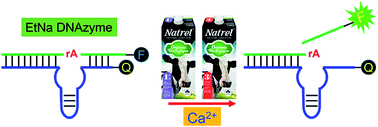Screening of DNAzyme mutants for highly sensitive and selective detection of calcium in milk
Abstract
Developing biosensors for Ca2+ detection is an important yet challenging analytical task, since it is quite difficult to distinguish Ca2+ from Mg2+, Cd2+ and even lanthanides in some cases. In addition to small molecule and protein based Ca2+ probes, DNA has recently emerged as a powerful platform for metal sensing. DNAzymes are DNA-based catalysts, and DNAzyme-based sensors are highly attractive due to their high stability, low cost and excellent sensitivity. EtNa is a recently reported RNA-cleaving DNAzyme that has high selectivity for Ca2+ over Mg2+ and Na+. In this work, a systematic mutation study was performed on EtNa, aiming to further understand its biochemical features and improve sensor performance. Among the 45 tested mutants, EtNa-C5T showed higher activity and even better Ca2+ selectivity compared to the original EtNa. The selectivity for Ca2+ over Na+ improved by ∼20-fold. In the presence of 1 mM Ca2+, C5T has a cleavage rate of 0.07 min−1. A catalytic beacon sensor was designed based on the C5T mutant with a detection limit of 11 μM Ca2+. This sensor was used to measure Ca2+ in five commercial milk samples and the results were compared to those from ICP analysis.



 Please wait while we load your content...
Please wait while we load your content...